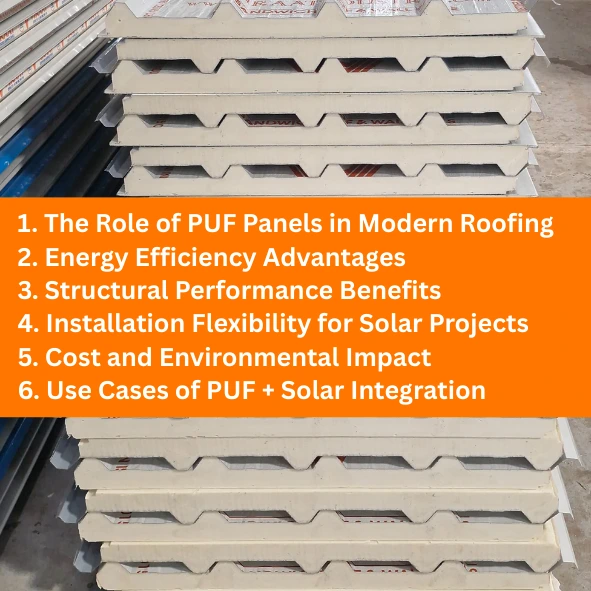
How PUF panels enhance energy efficiency the demand for renewable energy solutions grows, solar roofing systems are rapidly becoming a mainstream choice for residential, commercial, and industrial buildings. However, the effectiveness of solar panels doesn’t solely depend on their quality or efficiency—it also relies on the type of roofing material used beneath them. One such material gaining popularity is the PUF (Polyurethane Foam) panel, a versatile construction solution known for its insulation, strength, and durability. When paired with solar roofs, PUF panels create a high-performance system that optimizes energy generation while ensuring long-term structural reliability.
In this blog, we’ll explore how PUF panels enhance energy efficiency and structural performance in solar roof integration.

1. The Role of PUF Panels in Modern Roofing
PUF panels are sandwich structures composed of a rigid polyurethane foam core placed between two protective outer sheets—typically steel or aluminum. This design makes them lightweight yet highly durable, offering excellent thermal insulation and load-bearing capacity.
When it comes to solar roof integration, these features become especially valuable. Solar photovoltaic (PV) panels need a stable, insulated, and weather-resistant base to function efficiently over decades. PUF panels deliver exactly that, making them an ideal partner for sustainable building projects.
2. Energy Efficiency Advantages
a) Superior Thermal Insulation
PUF panels, though lightweight, are engineered with excellent compressive strength, allowing them to easily bear the added load of solar modules without compromising structural integrity. Their minimal weight also reduces stress on the main building framework, ensuring long-term stability and safety.
b) Airtight and Moisture Resistant
PUF panels are designed to resist moisture penetration and air leakage, two factors that can impact the efficiency of rooftop solar systems. By preventing heat loss or unwanted air infiltration, they ensure consistent indoor temperatures and minimize energy wastage.
c) Sustainable Energy Synergy
The combination of solar panels generating renewable energy and PUF panels reducing overall energy demand creates a highly efficient system. This synergy helps lower carbon footprints and brings long-term sustainability benefits to both homeowners and businesses.
3. Structural Performance Benefits
a) Lightweight Yet Strong
PUF panels, though lightweight, are engineered with excellent compressive strength, allowing them to easily bear the added load of solar modules without compromising structural integrity. Their minimal weight also reduces stress on the main building framework, ensuring long-term stability and safety.
b) Wind and Weather Resistance
Rooftop solar systems must withstand heavy winds, rain, and extreme weather. PUF panels provide a rigid, corrosion-resistant base that keeps solar mounting systems firmly in place. Their weatherproof properties also protect the underlying structure from leaks or damage.
c) Fire Safety and Long Life
Modern PUF panels are engineered with fire-retardant properties, offering additional safety in solar installations where electrical equipment is involved. Coupled with their long service life, they ensure both structural reliability and peace of mind.
4. Installation Flexibility for Solar Projects
PUF panels are highly adaptable to different solar installation methods. They allow easy mounting through bolts, rail systems, or adhesive solutions, depending on project needs. For large industrial warehouses or commercial facilities, this adaptability speeds up the installation process while keeping costs under control.
Additionally, their modular design makes them suitable for prefabricated buildings, site offices, and portable structures where solar roofs can be integrated seamlessly.
5. Cost and Environmental Impact
Although PUF panels may come with a slightly higher initial cost compared to traditional roofing materials, their long-term advantages make them a more valuable investment. Over time, building owners can achieve significant savings through:
Reduced maintenance expenses, since PUF panels offer strong resistance against corrosion, pests, and moisture.
Higher return on investment through the combined benefits of solar power generation and energy savings.
Greater returns through a combination of renewable energy production and reduced energy consumption.
From an environmental standpoint, this integration significantly reduces greenhouse gas emissions, supporting global sustainability goals.
6. Use Cases of PUF + Solar Integration
Industrial Warehouses: Large roof areas with solar + insulated roofing maximize energy efficiency and storage cost savings.
From offices to malls and hospitals, commercial complexes enjoy lower energy demands alongside greater solar power generation.
Residential Homes: Homeowners in hot climates gain comfort, lower cooling bills, and a sustainable energy supply.
Prefab Units: Quick-build modular homes or site offices can be delivered solar-ready with PUF roofing.
Conclusion
The future of construction lies in combining energy efficiency with renewable energy solutions. PUF panels, when integrated with solar roofing, create a powerful system that delivers thermal insulation, structural strength, and sustainability. By reducing energy losses, enhancing solar performance, and ensuring long-term durability, PUF panels prove to be more than just a building material—they are a foundation for smarter, greener infrastructure.
For businesses and homeowners planning to invest in solar energy, considering PUF panels as a roofing solution can significantly improve both performance and savings.
Frequently Asked Questions
PUF panels offer a stable, insulated, and weather-resistant base that supports solar PV installations. Their robust load-bearing capacity ensures long-term structural reliability—making them a perfect foundation for efficient and durable solar roofing systems.
The high thermal insulation of PUF panels reduces heat transfer between the building’s interior and exterior. This means buildings remain cooler in the summer and warmer in the winter, lowering the load on HVAC systems and increasing the net energy gains from solar panels.
The high thermal insulation of PUF panels reduces heat transfer between the building’s interior and exterior. This means buildings remain cooler in the summer and warmer in the winter, lowering the load on HVAC systems and increasing the net energy gains from solar panels.
Key factors include choosing panels with the right insulation performance and surface weathering resistance, as well as ensuring they are compatible with the structural and aesthetic requirements of solar mounting systems. The blog underscores the importance of using panels that provide both thermal and structural performance.
PUF panels stand out by offering a balance of thermal performance, structural support, and ease of integration. Unlike traditional metal or concrete roofs, PUF panels excel in insulation while meeting the load requirements of solar systems—though explicit comparisons aren’t made in the blog itself.



